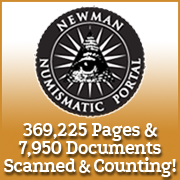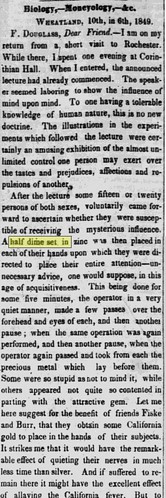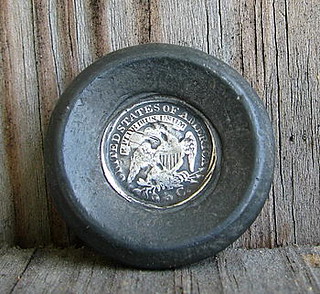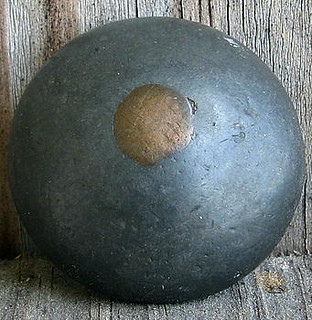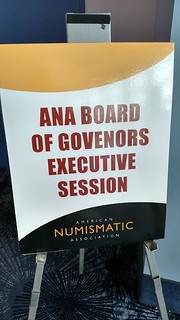
About UsThe Numismatic Bibliomania Society is a non-profit organization devoted to the study and enjoyment of numismatic literature. For more information please see our web site at coinbooks.org SubscriptionsThose wishing to become new E-Sylum subscribers (or wishing to Unsubscribe) can go to the following web page link MembershipThere is a membership application available on the web site Membership Application To join, print the application and return it with your check to the address printed on the application. Membership is only $20 to addresses in the U.S., $25 for First Class mail, and $30 elsewhere. For those without web access, write to: Terry White, Treasurer
AsylumFor Asylum mailing address changes and other membership questions, contact Terry at this email address: terrywhite5475@yahoo.com SubmissionsTo submit items for publication in The E-Sylum, just Reply to this message, or write to the Editor at this address: whomren@gmail.com BUY THE BOOK BEFORE THE COINSale Calendar |
- WAYNE'S WORDS: THE E-SYLUM AUGUST 14, 2016
- NLG HONORS SEVEN WHITMAN PUBLISHING AUTHORS
- U.S. MINT PUBLISHES 1974-D CENT BROCHURE
- NEWMAN NUMISMATIC PORTAL SCANS PENNY-WISE
- NOTES FROM E-SYLUM READERS: AUGUST 14, 2016
- MORE ON ELECTION COIN-FLIPPING
- JAMES F. ELMEN ON TERRORISM AND COLLECTING
- MORE ON THE ENCASED HALF DIME MYSTERY
- QUERY: VICTORIAN HALF PENNIES ENCASED IN IRON
- MORE ON 1794 DOLLARS
- GEORGE JOSEPH BAUER (1870-1961)
- 2016 FIDEM CONGRESS TO MEET IN BELGIUM
- NUMISMATIC VOCABULARY: BOGUS
- WAYNE'S NUMISMATIC DIARY: AUGUST 14, 2016
- QUERY: YEMENI COINS IN COLONIAL AMERICA
- ARTICLE HIGHLIGHTS SALE OF 1792 COINS
- HOW MUCH ARE OLYMPIC MEDALS WORTH?
- POLICE SOLVE WWI SOLDIER MEDAL MYSTERY
- MOVIE PROP MONEY GETS DRUG BUYER A BEATING
- INTERVIEW WITH COUNTERFEITER FRANK BOURASSA
- FEATURED WEB SITE: TOM CHAO'S PAPER MONEY GALLERY
Click here to access the complete archive
To comment or submit articles, reply to whomren@gmail.com
WAYNE'S WORDS: THE E-SYLUM AUGUST 14, 2016
New subscribers this week include: Christian Cloke (subscriber no. 2,000!), Larry Meiteles, and Cole. Welcome aboard! We now have 2,001 subscribers.
If you're wondering why the numbers don't seem to add up, we had one person unsubscribe during the week, the ungrateful wretch. What do you want for free? It's actually quite rare for someone to unsubscribe - usually that's only when people move to a new address and immediately resubscribe. Generally, people sooner die off than unsubscribe.
Roger Siboni writes:
Just as I did at 1,000 followers, let me congratulate you on establishing and maintaining one of the first blogs I can remember. Before Instagram, before Twitter, before Facebook was founded..... Sometime after "The Well"....... Pretty amazing.
This week we open with some numismatic literature events at the recently-concluded ANA World's Fair of Money, new material on the Newman Numismatic Portal, and notes from E-Sylum readers on various topics.
Other topics this week include election coin-flipping, encased Victorian pennies, dealer Gerge Bauer, the 2016 FIDEM Congress, Olympic medals and movie prop money.
To learn more about Numismatic Literary Guild (NLG) winners, the 1974-D aluminum cent, modern paper money chopmarks, the identical twin 1794 dollars, the bogus machine, Mr. Redbook, Lutefisk and counterfeiter Frank Bourassa, read on. Have a great week, everyone!
Wayne Homren
Editor, The E-Sylum

NLG HONORS SEVEN WHITMAN PUBLISHING AUTHORS
The Numismatic Literary Guild announced the awards for its annual Writers Competition at the American Numismatic Association World’s Fair of Money in Anaheim, Thursday, August 11, 2016.
Seven Whitman Publishing authors received recognition in categories covering U.S. coins, U.S. paper money, world coins, numismatic investments, and tokens and medals. They were:
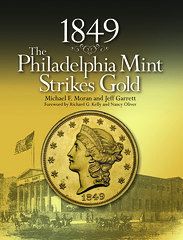
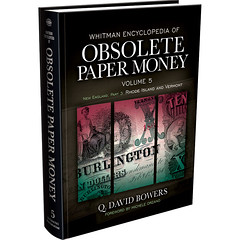
Michael Moran and Jeff Garrett: “Best Specialized Book, U.S. Coins,” for 1849: The Philadelphia Mint Strikes Gold, a chronicle of the trials and tribulations of the U.S. Mint in the first half of the 19th century and the tremendous impact that the 1848 discovery of gold in California had upon that institution and the nation as a whole.
David Bowers: “Best Specialized Book, U.S. Paper Money,” for the Whitman Encyclopedia of Obsolete Paper Money, volume 5 (the fourth of four volumes covering New England) and volume 6 (the first of three volumes on the South Atlantic states)—in-depth studies of the state-chartered banks that issued paper currency from the 1790s to the 1860s.
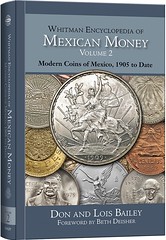
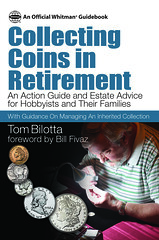
Don and Lois Bailey: “Extraordinary Merit, World Coins,” for the Whitman Encyclopedia of Mexican Money, volume 2, a history and price guide covering the modern coinage of Mexico, 1905 to date, including circulating, commemorative, and bullion coins.
Tom Bilotta: “Extraordinary Merit, Numismatic Investments,” for Collecting Coins in Retirement: An Action Guide and Estate Advice for Hobbyists and Their Families, compiling the author’s 20-plus years of experience observing the specialized challenges and opportunities collectors see after they retire, and the questions and situations their heirs encounter.
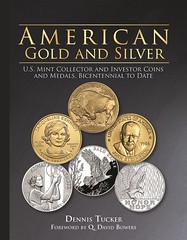 Dennis Tucker: “Extraordinary Merit, Tokens and Medals,” for
American Gold and Silver: U.S. Mint Collector and Investor Coins and Medals, Bicentennial to Date, a history, comprehensive
catalog, and market study of the Mint’s recent bullion-coin and related products—everything outside of American Eagles, including the
American Arts gold medallions, First Spouse and American Buffalo gold coins, America the Beautiful silver coins, and others.
Dennis Tucker: “Extraordinary Merit, Tokens and Medals,” for
American Gold and Silver: U.S. Mint Collector and Investor Coins and Medals, Bicentennial to Date, a history, comprehensive
catalog, and market study of the Mint’s recent bullion-coin and related products—everything outside of American Eagles, including the
American Arts gold medallions, First Spouse and American Buffalo gold coins, America the Beautiful silver coins, and others.
“Whitman Publishing is pleased to bring great new books to the hobby community every year,” said Whitman president Mary Burleson. “Congratulations to our award-winning authors; to everyone who participated in the NLG Writers Competition for 2016; and to the NLG for promoting excellence in numismatic research and writing.”
Whitman is the Official Supplier of the American Numismatic Association, and ANA members receive 10% off all direct purchases of Whitman books, folders, albums, and other products.
To read the complete article, see:
Numismatic Literary
Guild Awards 2016 Prizes to Seven Whitman Publishing Authors
(http://news.coinupdate.com/numismatic-literary-guild-awards-2016-prizes-to-seven-whitman-publishing-authors/)
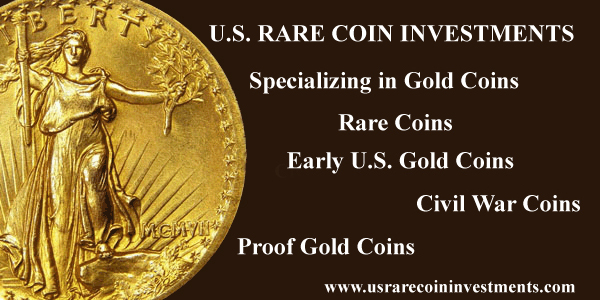
U.S. MINT PUBLISHES 1974-D CENT BROCHURE
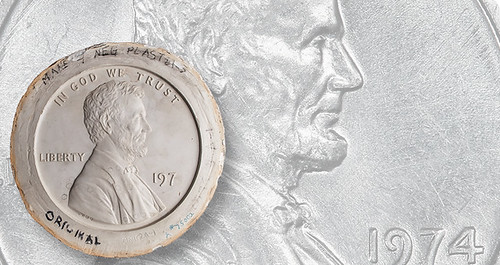
The United States Mint posted on its website information from a four-page, full-color informational brochure detailing the production of the 1974-D Lincoln cent struck in aluminum.
Printed copies of the brochure were being distributed at the U.S. Mint's booth Aug. 9 to 13 at the American Numismatic Association's World's Fair of Money in Anaheim, Calif., where an example of the aluminum cent is on display.
The color brochure illustrates obverse and reverse images of the 1974-D aluminum cent that was returned to the Mint earlier this year pursuant to litigation.
The brochure also illustrates an original Lincoln cent obverse plaster model that would have been used in the die making process in 1974. The D Mint mark of the Denver Mint would have been manually punched into each working die for production.
According to the brochure, during the Mint's examination of compositional alternatives for the cent amid rising copper prices, experimental sheets of an aluminum alloy were sent to the Denver facility to be cut into cent blanks and shipped back to the Philadelphia Mint, where experimental strikes were already being pursued in aluminum.
"This was done because Denver's blanks were slightly larger than the ones used in Philadelphia and the experimental team wanted to see if the different size affected the alloy's utility," according to the brochure's details. "The Denver Mint was not authorized to strike any experimental aluminum cent and most of the blanks were returned to Philadelphia as instructed.
"Nonetheless, at least one Denver Mint employee recalls striking experimental cents on the aluminum blanks using an existing 'D' marked die. This effort was unauthorized and in direct contradiction to official instructions."
Randall Lawrence, the son of former Assistant Denver Mint Superintendent Harry Edmond Lawrence, discovered the 1974-D aluminum cent among items that had been presented to his father at his 1980 retirement shortly before his passing. The items were bequeathed to Randall Lawrence.
Randy Lawrence initially sold the 1974-D aluminum cent and other coins for an undisclosed sum in September 2013 to Michael McConnell, owner of La Jolla Coin Shop in La Jolla, Calif.
After McConnell learned the potential worth of the aluminum cent, he decided to partner with Randy Lawrence in the public auction of the cent in April 2014 by Heritage Auctions.
The cent was withdrawn from the sale lineup shortly before the 2014 auction after the U.S. Department of Justice, on behalf of the Mint, filed a civil complaint seeking return of the experimental 1974-D aluminum cent. Randy Lawrence and McConnell filed their own complaint, but eventually withdrew the action, subsequently returning the piece to the Mint in March 2016.
One of the stipulations for the coin’s return was that McConnell could break the cent out of its PCGS holder so he could retain the grading label.
The 1974-D aluminum cent display case had the cent high on a thin rotating pedestal under a large glass or plexiglass box. It was hard to see many details from that distance, but the silver color clearly distinguished it from other cents of the era. I think it was the first time I'd seen one of these. i remember news of the possible transition to aluminum in mid 70s promting me to run out to coin shows and buy up many of the dates and mintmarks needed to fill out my Whitman 1909-1940 Lincoln Cent folder. I never bought the top keys though, and those gaping holes in my set still remain. -Editor
To read the complete article, see:
U.S. Mint offers historical
brochure for 1974-D Lincoln cent struck in aluminum
(www.coinworld.com/news/us-coins/2016/08/mint-offers-brochure-on-1974-d-aluminum-cent.html)
To read the earlier E-Sylm articles, see:
IGHT CONTINUES OVER 1974-D ALUMINUM CENT
(www.coinbooks.org/esylum_v17n36a27.html)
U.S. MINT REGAINS DISPUTED 1974-D ALUMINUM CENT
(www.coinbooks.org/esylum_v19n12a18.html)
MORE ON THE 1974-D ALUMINUM CENT LAWSUIT SETTLEMENT
(www.coinbooks.org/esylum_v19n14a16.html)
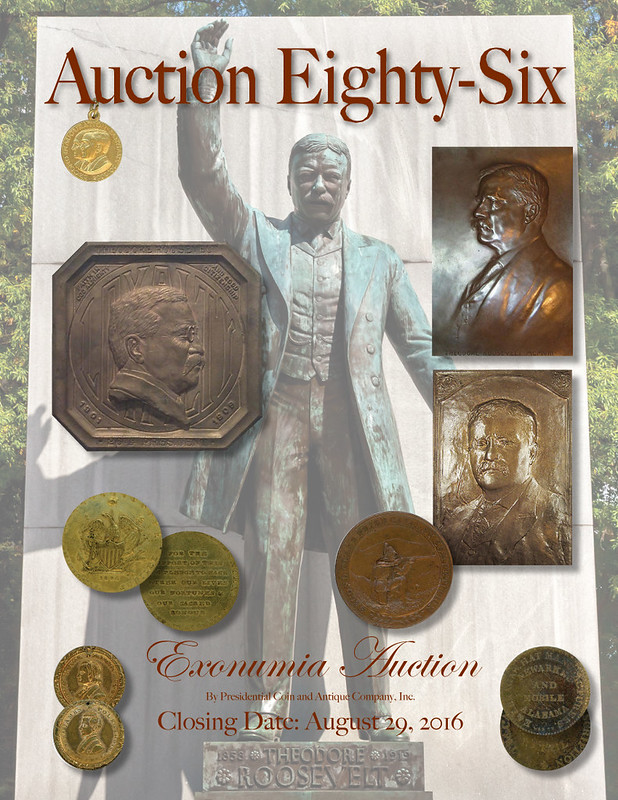
NEWMAN NUMISMATIC PORTAL SCANS PENNY-WISE
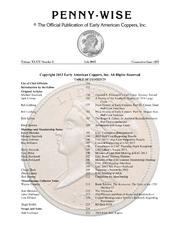 Our featured item this week is Penny-Wise, the journal of the Early American Coppers (EAC) club. The Newman Portal contains the
issues from 1967 (the inauguration of the journal) through the year 2013. Penny-Wise is one of the premier specialty publications in American
numismatics, with editor Harry Salyards’ column being a regular treat. Indeed, the Numismatic Literary Guild recognized Salyards’ efforts with an
award at the 2016 ANA convention.
Our featured item this week is Penny-Wise, the journal of the Early American Coppers (EAC) club. The Newman Portal contains the
issues from 1967 (the inauguration of the journal) through the year 2013. Penny-Wise is one of the premier specialty publications in American
numismatics, with editor Harry Salyards’ column being a regular treat. Indeed, the Numismatic Literary Guild recognized Salyards’ efforts with an
award at the 2016 ANA convention.
The Newman Portal is text searchable, and terms such as “strawberry leaf” or “Jefferson head” produce a good number of hits in Penny-Wise. This writer’s favorite large cent, the Sheldon-276, known for its seemingly random die rotations, is likewise discussed. A search on “S-276” uncovered a number of interesting articles on the subject. The Newman Portal acknowledges Bill Eckberg, EAC President, for his assistance with the project.
Link to Penny-Wise on the Newman Portal:
https://nnp.wustl.edu/library/publisherdetail/511683

NOTES FROM E-SYLUM READERS: AUGUST 14, 2016
Another Modern Chopmark on a $100 Bill
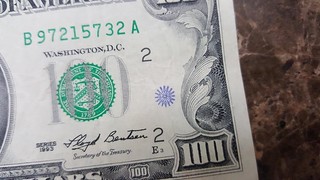 Web site visitor Esperanza Beatriz Vazquez writes:
Web site visitor Esperanza Beatriz Vazquez writes:
I've got a old one hundred dollars bill with this mark. Can you tell from which country or bank this comes from? is a very interesting and neat bill.
I'm afraid I have no information on where any of these marks come from. The people who put them there know, but no one has compiled a catalog. We may never know where most of these came from. Interesting mark, though. I like it.
To read earlier E-Sylum articles, see:
CHOPMARKS ON MODERN U.S. PAPER MONEY (www.coinbooks.org/esylum_v17n07a21.html)
MORE CHOPMARKS ON MODERN U.S. PAPER MONEY
(www.coinbooks.org/esylum_v17n08a08.html)
Historical Pricing and Inflation in Britain
Ron Haller-Williams writes:
With regard to historical pricing and inflation, here's something which offers RPI and CPI for Britain, purportedly from 1209 !!! It also gives lots of other useful info, and is well worth a look. I have not yet properly looked at it, let alone trying to compare it with "Chronicon Preciosum", but ...
To read the complete Wikipedia article, see:
Pound sterling (https://en.wikipedia.org/wiki/Pound_sterling)
To read the earlier E-Sylum articles, see:
MORE ON "TOURAINE POUNDS" (www.coinbooks.org/esylum_v05n42a14.html)
SOURCE FOR HISTORICAL CONSUMER PRICES
(www.coinbooks.org/esylum_v10n10a21.html) MORE SOURCES FOR HISTORICAL CONSUMER
PRICES (www.coinbooks.org/esylum_v10n11a16.html)
Marc Isambard Brunel in New York
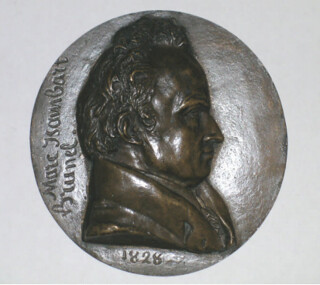 Scott Miller writes:
Scott Miller writes:
I was happy to read about Marc Isambard Brunel and his son, Isambard Kingdom Brunel in the last two issues. The father should be well known to readers of The E-Sylum, as he was briefly Chief Engineer of the City of New York, and associated with the Castorland colony. Both were mentioned in my article on the David D’Angers medal of Marc Isambard Brunel in the February 2010 issue of the MCA Advisory.
To read the complete article, see:
Marc Isambard Brunel: A Portrait Plaque By David
D’ Angers (www.medalcollectors.org/pdf/The%20%20MCA%20Advisor%20February%202010.pdf)
Grace Hopper and COBOL
Ron Abler writes:
Ken Berger’s anecdotes about RADM Grace Hopper prompted me to review my own Navy log, and I discovered that I erred when I said she was in her 80s when I served with her in the Washington Navy Yard from 1984 until her retirement on board the USS Constitution in Philadelphia on August 14, 1986. At that time, she was the oldest active-duty officer in the Navy at the age of ‘only” 79 years, 8 months, and 5 days.
While popularly known for her computer “bug” and her 11.80-inch-long copper wire souvenirs called “nanoseconds,” she was more respectfully acclaimed as “Grandma COBOL.” She was the co-developer of COBOL (Common Business-Oriented Language) in 1959. That language was so complex (in its day) that it was deemed by many to be impossible ever to develop a compiler for it. Undeterred, Grandma COBOL went on to develop a successful COBOL compiler.
COBOL was so pervasive in business computing that, in 1986 when she retired, my Directorate at the Navy Regional Data Automation Center (NARDAC) was still managing fourteen individual minicomputers, each of which ran a single application (for example, calculating and printing all the Navy paychecks for the National Capitol Region) and all of which were still running in COBOL!
To read the earlier E-Sylum article, see:
NOTES FROM E-SYLUM READERS: AUGUST 7, 2016 : Another Encounter With Grace
Hopper (www.coinbooks.org/esylum_v19n32a17.html)
THE BOOK BAZARRE
MORE ON ELECTION COIN-FLIPPING
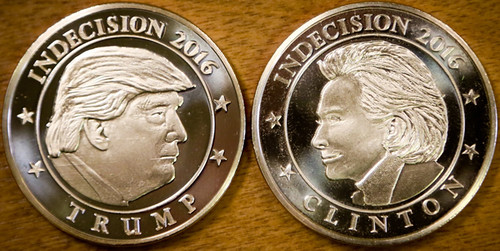
Mel Wacks writes:
The "likeness" of Hillary Clinton is just plain awful on INDECISION 2016: A FLIPPING COIN FROM LONG-STANTON The "artist" should be punished by having to listen to Trump's speeches for 24 hours! Or for that matter, Hillary's speeches.
I got to see one of these at Steve Hayden's table at the ANA convention in Anaheim. They look better in person. All are prooflike and not really suitable for actually flipping. -Editor
To read the earlier E-Sylum article, see:
INDECISION 2016: A FLIPPING COIN FROM LONG-STANTON
(www.coinbooks.org/esylum_v19n32a36.html)
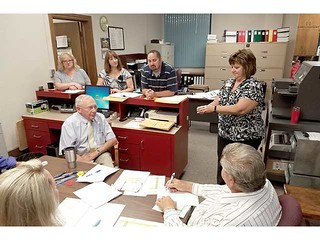 Rarely is there a tie election in Barton County that must be determined by a flip of the coin. But, Monday morning, two township level
primary races were decided by heads or tails. The coin flip took place in the County Clerk’s Office as the County Commission met as the Board of
County Canvassers.
Rarely is there a tie election in Barton County that must be determined by a flip of the coin. But, Monday morning, two township level
primary races were decided by heads or tails. The coin flip took place in the County Clerk’s Office as the County Commission met as the Board of
County Canvassers.
The first tie came on the Republican ticket for the Lakin Township treasurer. Incumbent Mark Hammeke and Corey Robl (both write-in candidates) each received four votes.
County Clerk Donna Zimmerman flipped the large silver coin provided by Commissioner Homer Kruckenberg and Robl won.
The second duel came between incumbent Dale Dirks and Mark Schultz on the Republican ticket for the Pawnee Rock Township trustee seat. Both write-ins, they each garnered three votes. Again, the challenger came out on top with Schultz winning.
To read the complete article, see:
Two tie township primaries force coin tosses
(www.gbtribune.com/section/69/article/98344/)
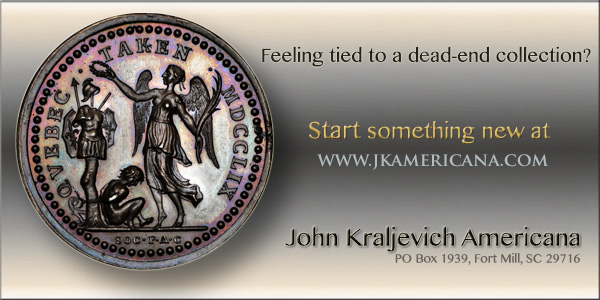
JAMES F. ELMEN ON TERRORISM AND COLLECTING
I have been going through my library for several months and finding what I need to scan into my files for future use and then finding a home for the hardcopy. So far, I have probably gone through several thousand price lists, auction catalogs and periodicals and just now seeing a dent in the size of my library. I just found the following comments on the World-Wide Coins of California World Coin List No. 22 February 1986 by James F. Elmen:
As this list is mailed, I am leaving for my annual winter buying trip to Europe. Accommodations should be readily available as tourist traffic is down now that Europe has been officially designated Lybia's vacation paradise and proving grounds. I was fortunate not to have not been injured when I witnessed the 1977 Munich terrorist bombing from entirely too close a vantage point but it left me with a vivid mental image of the impact of this cultural anarchy.
Terrorism is by no means a 20th Century development. "Mad bombers" with nebulous and real grudges against existing political and financial powers became a fixture with the advent of the Industrial Revolution but I believe they are in fact proof of the success of Western culture and ethics, for terrorism can only have an impact in a culture where human life and the rights of the individual have value. We note the lack of interest in Lybian excursion cruises to Cambodia and North Korea and for that matter we haven't heard of any hostage crisis at the annual Mongolian People's Yak Wrestling Festival. You can't score any points threatening lives that are an asset to the state but worthless as individuals.
One may ask what this has to do with collecting foreign coins and medals and the answer is: everything! This culture, where human life and liberty are so dear that they are apt targets for political blackmail, is the same culture where the ability and desire is instilled in the private individual to contemplate history and art through the collection and study of tangible artifacts, bringing him a personal awareness of his place in the world, the transience of the individual and the permanence of knowledge and beauty.
The collector is the custodian of the pageant of coins and medals that attest to the passing of the great and infamous, of battles and plagues, building the new and destroying the old and almost all displaying symbols of hope for assistance from some representation of the Supreme Being. We hope that today's collectors appreciate the long tradition of collecting of which they are a part, and their right to participate.
This was some kind of writing back in 1986 but it works for today too!

MORE ON THE ENCASED HALF DIME MYSTERY
Below is a link to the original item that kicked off Julia's search, a woman's yard sale find. The images of this piece do a better job of showing the shape and contours of the encasement, so I'm reproducing them here, along with the 1849 newspaper article Julia located. It's easy to see how these would nicely fit into the palm of a hand. -Editor
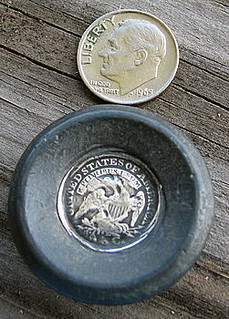 Found this at a yard sale yesterday. It appears to be a half dime set in lead, but I can't figure out why. I don't even know if
it's a real coin, although it appears to be silver. The lead is cup shaped, and on the reverse there is a spot of brass or copper in the center.
I put the modern dime next to it for size reference, but even though they look to be the same size in the pic, the half dime is a little bit smaller.
Not sure how much of the edge of the coin is in the lead though. Since I've never seen an actual half dime, I don't know how big they are.
Any ideas on why it is set in lead, or if it is a real coin? It has me puzzled.
Found this at a yard sale yesterday. It appears to be a half dime set in lead, but I can't figure out why. I don't even know if
it's a real coin, although it appears to be silver. The lead is cup shaped, and on the reverse there is a spot of brass or copper in the center.
I put the modern dime next to it for size reference, but even though they look to be the same size in the pic, the half dime is a little bit smaller.
Not sure how much of the edge of the coin is in the lead though. Since I've never seen an actual half dime, I don't know how big they are.
Any ideas on why it is set in lead, or if it is a real coin? It has me puzzled.
To read the complete discussion, see:
Half Dime set in Lead - Help!
(www.treasurenet.com/forums/what/305476-half-dime-set-lead-help.html)
To read the earlier E-Sylum article, see:
THE ENCASED HALF DIME MYSTERY (www.coinbooks.org/esylum_v19n32a32.html)

QUERY: VICTORIAN HALF PENNIES ENCASED IN IRON
Julia Purdy writes:
I have my own mystery encased coins (photos attached). I'd like to ask the E-Sylum readership if anyone has any ideas about them. There are Victorian bronze half pennies and are encased in iron. I picked them up on eBay separately a few months apart from 2 different UK sellers. I came across them as I was mulling over the encased half dimes and couldn't resist purchasing them.
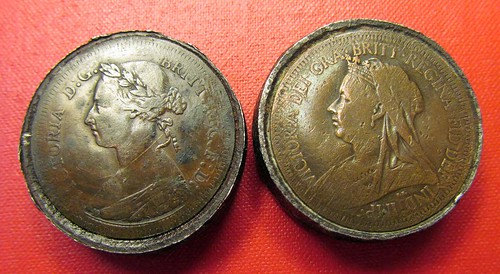
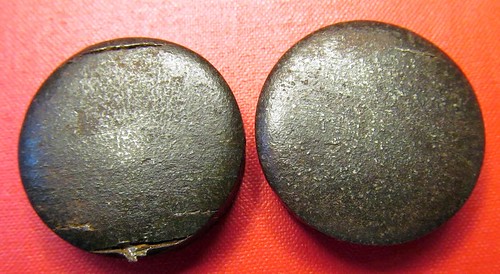
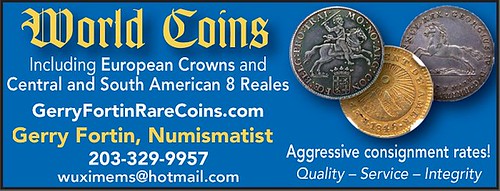
MORE ON 1794 DOLLARS
Bob Stark writes:
I knew Jules Reiver quite well--we spoke or met at least weekly for decades. I can't recall any such mention of 1794 dollars. It is now well known that his 1794 dollar of many years standing was a counterfeit. He learned of it when our mutual friend Woody Blevins bought his 1794 dollar and Jules noted the similarity, The two specimens were sold in the Heritage Sale of his collection in 2006.
Jules and I edited the Lettered Edge, a short live early dollar newsletter of the later 1970s. Jules would have written about his experience if it occurred in that period.
As for the counterfeit 1794 dollar, I vividly recall sitting at the counter in Jules' kitchen when he handed me two 1794 dollars and asked what I thought of them. When I got over the shock of personally handling TWO unslabbed rarities I quickly noticed that the two coins were the same - same wear spots, same adjustment marks, same rim dings, etc. EXACTLY the same.
Now, I knew enough about early U.S. coins to know that no two are exactly alike. The manufacturing process was inexact, and of course, once in circulation the two would likely not recieve the same wear in the same places. And I knew that if two guys both claim to be Elvis, at least one of them is lying. So one or both were copies.
Jules was patient while I re-examined each coin. Finally I had my Eureka moment - one of the coins had a flattened spot on the edge, where a sprue had likely been filed off. That was the copy, and the other was the original used to make the mold.
Jules told me he first learned of a problem with his coin when he got a phone call from Jack Collins. Jack was compiling his book on the 1794 dollars. Jack read Jules the entry on his coin, and told Jules he'd gotten it from a particular auction sale. I'm paraphrasing here, but the conversation went something like this: "No, I didn't"; "Yes, you did"; "No, I didn't"; "Yes, you DID - it matches the plate exactly." "Well, that's not my coin - I didn't buy it there."
At least, that's how I remember the story. Later Jules bought the Blevins coin and reunited the pair. Jules's coin was the fake. The genuine Blevins coin was offered as lot 23464 in the January 2006 Heritage sale of the Reiver collection. The lot description describes the exchange with Jack Collins taking place through letters.
-Editor
Bill Eckberg writes:
Regarding 1794 dollars, I recently visited the Rijksmuseum in Amsterdam, The Netherlands. Along with the many masterpieces by Rembrandt, Vermeer and others, there was a small coin cabinet. In it there was a single US coin: a 1794 dollar. It looked to my eye to be XF or better and pretty nice for one of those.
According to a couple of friends, this coin is not listed in the inventories of 1794 dollars. I suppose that since The Netherlands was the first country to recognize the US during the Revolutionary War, we shouldn’t be too surprised that the Dutch have some of our important early coins. It makes me wonder how many more early US coins reside in foreign collections and museums, unknown to American numismatists.
Bill adds:
Really rare coins rarely get rarer.
To read the earlier E-Sylum article, see:
A BRIEFCASE OF 1794 DOLLARS (www.coinbooks.org/esylum_v19n32a22.html)
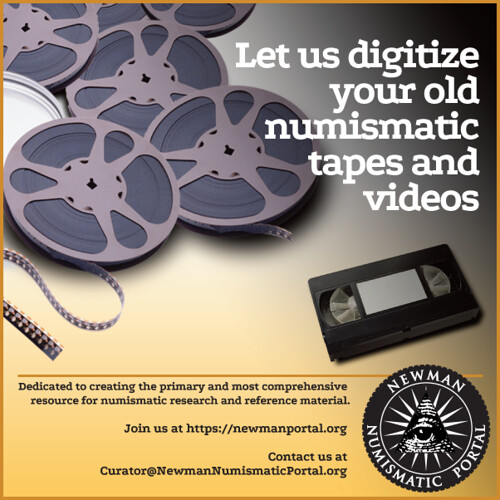
GEORGE JOSEPH BAUER (1870-1961)
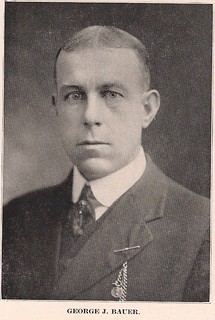 George Joseph Bauer (1870-1961), was born on September 15, 1870, son of Marcellus Bauer (1841-1914), an Alsatian immigrant trained as a
butcher, and Frances Egerer Bauer (1850-1936), a native of New York born of a father from Bavaria and a mother from Prussia.
George Joseph Bauer (1870-1961), was born on September 15, 1870, son of Marcellus Bauer (1841-1914), an Alsatian immigrant trained as a
butcher, and Frances Egerer Bauer (1850-1936), a native of New York born of a father from Bavaria and a mother from Prussia.
Bauer was a life-long resident of Rochester, New York. He is especially noted as being one of the foremost authorities on ancient Greek and Roman coins and for owning one of the best collections in the world.
From birth he inherited a rich European cultural background and a love of ancient Greek and Roman numismatics connected to that world. Since the 1870’s, Rochester, New York is ranked 7thamong the most active cities in America in the field of numismatics, home of Henry Augustus Ward’s famous Ward’s Museum. According to his various published biographical sketches he began coin collecting at age 12 years old, i.e., in 1882 when he was a student at St. Joseph’s Catholic School.
In September 1888, he attended the International Fair and Exposition held at Buffalo from September 4th to 14th, and was awarded first prize for his collection of ancient coins being given the copper medal “Awarded by the Buffalo International Fair and Exposition, 1888”. The 1889-1890,City Directory of Rochester, New York listed young George as a coin dealer at 73 Front Street.
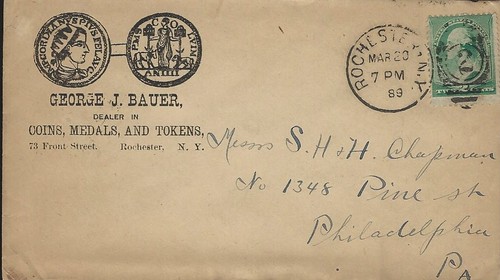
He joined the ANA in April 1892... As a coin dealer he ran ads in earliest issues of The Numismatist.
On January 4, 1912, George J. Bauer, together with Dr. George P. French, George A. Gillette, Louis G. Amberg, Harry H. Yawger, Joesph A. Koeb, and nine others met at Hotel Rochester, Main Street, Rochester, New York, and founded the Rochester Numismatic Association. Perhaps following the example of the 18th century "Tuesday Club" the newly founded Rochester Numismatic Association (RNA) scheduled their meetings to be held on the first and third Tuesday of every month, except July and August, which was held only once per month. The RNA soon joined the ANA and was recognized as one of the first branches and designated "local branch two".
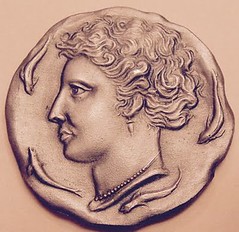
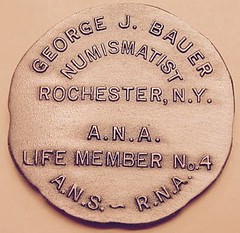
Sometime between 1922 and 1932 he had Alphonse Anton Kolb (1893-1983) design his 34 mm bronze or nickel store card. On the obverse : bust head of the Sicilian Naiad Nymph of Syracuse Arethousa facing left wearing a pearl necklace framed by four circling dolphins, an idealized version of an ancient Syracusan coin. Reverse legend : GEORGE J. BAUER/NUMISMATIST/ROCHESTER, N. Y./A.N.A./LIFE MEMBER No.4/A.N.S.-R.N.A.
He was elected to the Board of Governors of the ANA in 1922, and became Life Member No. 4 at that time. He was elected 17th president 1930-1932 at the ANA Convention at Buffalo. He attended all of the ANA Conventions from 1912 until 1960 except two, when his wife died in 1951 and once when he was seriously ill.
He planned on attending the August 1961 ANA Convention in Atlanta, Georgia. While preparing an exhibition for the Rochester Numismatic Association’s meeting, he fell at his home at 1462 Culver Road, and broke his hip on May 16, 1961. He was rushed to Park Avenue Hospital for an operation to set his hip. He died on Thursday, May 25, 1961 in Park Avenue Hospital, Rochester, New York, from post-operative complications. His funeral Mass was celebrated at St. Ambrose Catholic Church. He is buried in the Holy Sepulchre Cemetery.
His remaining collection of coins was sold posthumously by his estate through Lester Merkin on November 20, 1968. George J. Bauer was inducted into the ANA Numismatic Hall of Fame in 1969.
To read the complete article, see:
BAUER, GEORGE JOSEPH
(https://sites.google.com/a/numismaticmall.com/www/numismaticmall-com/bauer-george-joseph)
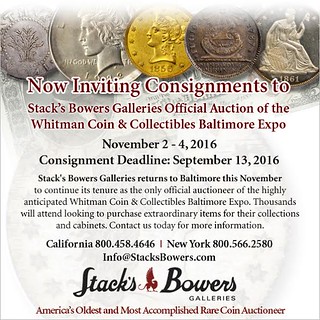
2016 FIDEM CONGRESS TO MEET IN BELGIUM
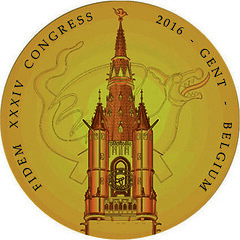 The annual congress of FIDEM (Fédération Internationale de la Médaille d'Art, or in English, the International Art Medal Federation,
will hold its annual congress in Belgium September 6-11, 2016. For more information, see the group's web site. -Editor
The annual congress of FIDEM (Fédération Internationale de la Médaille d'Art, or in English, the International Art Medal Federation,
will hold its annual congress in Belgium September 6-11, 2016. For more information, see the group's web site. -Editor
Art-Medal World Congress &International exhibition of contemporary medals
FIDEM XXXIV 6 – 10/11 September 2016 Gent, Belgium
For more information, see:
FIDEM BELGIUM 2016 (www.fidem-belgium.com)
NUMISMATIC VOCABULARY: BOGUS
bogus
adjective | BOH-gus
Definition
: not genuine : counterfeit, sham
You may know bogus as a slang word meaning "uncool" or simply "no good," but did you know that bogus has actually been a part of English since the early 1800s? Not only was the word coined then, it was actually doing some coining of its own, so to speak. Back then, a bogus was a machine used to make counterfeit coins. No one knows for sure how this coin-copying contraption got its name, but before long bogus had also become a popular noun for funny money itself or for a fraudulent imitation of any kind. The more general "phony" adjective began being used about the same time.

WAYNE'S NUMISMATIC DIARY: AUGUST 14, 2016
Wednesday, August 10
My alarm rang at o-dark-thirty Wednesday morning and I left the house before the newspaper had even arrived. I drove over to Dulles Airport
and for a while was the only passenger on the parking lot shuttle. Check-in was a breeze thanks to TSA-Pre and I made it to my gate half an
hour ahead of my 6:05am boarding time.
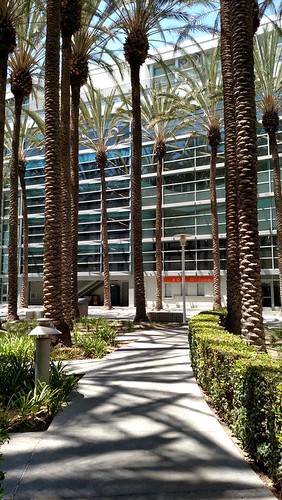 The United flight was fine and arrived a bit early five hours later, around 9:30 California time. A Supershuttle came within minutes and
after a couple nearby stops deposited me at the Anaheim Hilton across from Disneyland.
The United flight was fine and arrived a bit early five hours later, around 9:30 California time. A Supershuttle came within minutes and
after a couple nearby stops deposited me at the Anaheim Hilton across from Disneyland.
After checking in and dropping my luggage in my room I headed over to the convention center next door. I quickly found two large conventions going on, but neither one was the ANA. Did I fly in to the wrong city? But after wandering around for a while I stumbled across a sign for the Stacks Bowers auction and headed toward it.
It's an interesting game with me to track who's the first numismatic friend I encounter at a major convention. Sometimes I spot them first, sometimes they find me. As I came up the escalator I spotted a tall man in a suit holding a conversation outside the auction room, and I recognized him as Stacks Bowers President Brian Kendrella.
I asked an employee for help and she kindly directed me to the bourse floor downstairs, where I made a beeline for the table shared by Len Augsburger and Joel Orosz, where they were promoting their upcoming book on 1792 coinage. The table was busy and I didn't get a chance to talk with Len until much later in the day.
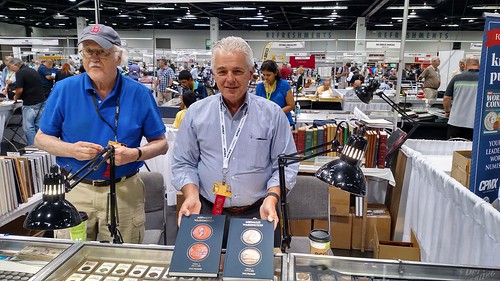
Charlie Davis and Neil Musante
Just a few steps away was Charlie Davis' table where he and Neil Musante were displaying a fresh-off-the-press copy of Neil's new two-volume work Medallic Washington. It's a beautifully designed and produced work, with excellent full color photos throughout. They'd already sold the eight other copies they had on hand, and had taken many orders. I put in an order myself.
I asked how the book came to be published by Spink, and Neil told me about a chance meeting with Spink's Phil Skingley. Phil was aware of the manuscript and asked how it was coming. Neil hadn't yet approached a publisher and Phil expressed interest. After reviewing the manuscript Spink was in.
Next I went to the Kolbe &Fanning table and spoke with Maria Fanning about the upcoming Asylum issue, where I've submitted an article covering the history of my experience of applying technology to numismatics.
Next I wandered the bourse floor for a bit, starting with the nearby U.S Mint booth, then heading to the club aisles. I spoke to two men manning the Orders and Medals Society of America booth, then with Chelsea Highfill at the Silver Dollar Collectors Roundtable booth. She thought the group would be happy to place their publication content in the Newman Numismatic Portal and directed me to her father John Highfill in a booth in the 600 aisle.
Chelsea's a medical student and a voracious reader on medical topics, so I offered to send her my copy of The Golden Age of Quackery, which I had purchased years ago to learn more about patent medicine makers advertising on tokens and encased postage stamps.
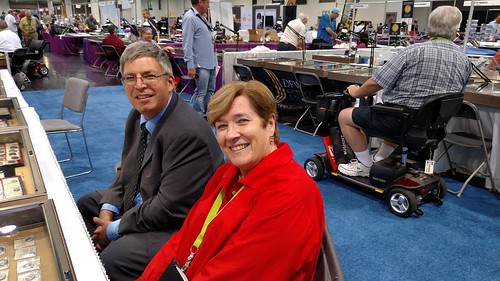
Oliver Hoover and Mary Lanin
In another aisle I ran into Mary Lanin, who introduced me to Oliver Hoover of the American Numismatic Society. Other folks I spoke briefly with included Julian Leidman and Steve Hayden, who had an example of the "Indecision 2016" flipper medal at his table. Several others were busy with customers at their tables, including Dave Wnuck.
Sundman Interview
At 2pm I went to the room where they were filming an interview with David Sundman of Littleton Coin Company. There was a good crowd
present. Numismatist Editor Barbara Gregory was doing the interviewing with David Lisot filming. I'll look forward to the final
video.
Afterwards I spoke with David Sklow, Barbara Gregory and others before heading back to the bourse for a while. There I had a good conversation with Steve Roach about Money Artist J.S.G. Boggs.
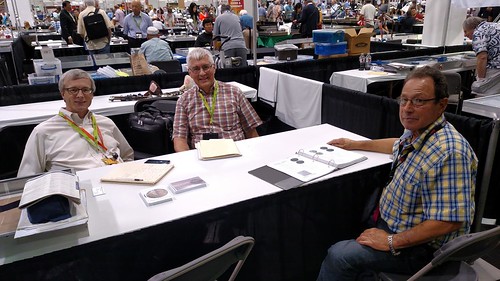
Len Augsburger Joel Orosz, and Alan Weinberg
Back at the Orosz-Augsburger table I had a chance to speak with Alan Meghrig, and E-Sylum regulars Allan Schein and Alan Weinberg. Meghrig offered some coin album and book wholesaler material for digitization in the Newman Portal, and Weinberg offered to proofread the 1792 draft and provide information about the 1792 coinage in his collection.
Schein had been having a great reception for his new book on Pratt's Indian coinage and discussed his plans for regular hardbound and deluxe editions. Brad Karoleff also happened by.
Dinner With Mr. Redbook
I had no preplans for the rest of the evening but was ready for dinner. After checking prices on the hotel restaurant menu I wandered back
to the Food Court. While deciding what to order I ran into none other than Ken Bressett, editor of the classic A Guide Book of United
States Coins. He was looking for a quick dinner as well and I invited him to sit with me. We ordered our food and found a table outside
in the evening sun.
We had a great conversation, covering topics including The E-Sylum, the Newman Portal and CoinArchives.com, which he's been using to catalog ancient coins in his collection.
Next I went to the Hilton lobby bar where I met E-Sylum reader R.V. Dewey for the first time. We had a drink while looking at coins and coin images from multiple sources. I encouraged him to look into the Newman Portal for some of his research questions and I agreed to obtain a copy of an interesting article relating to Longacre that's not yet digitized.
Thursday, August 11
A Bourse Walkabout
Thursday morning I went back to the bourse and crossed paths with several friends including Kerry Wetterstrom of CNG, Tom Uram of PAN,
Julian Leidman, and Jimmy Hayes, who seemed to be everywhere, although we never got a chance to chat.
I tried visiting E-Sylum advertisers, but some (including Wayne Herndon and Doug Winter) were busy with customers and I didn't want to interrupt. At John Kraljevich's table I ran into Karl Goetz specialist Henry Goodman. Later I spoke to Peter Preston-Morley of Dix Noonan Webb, Bob Schwartz of Archives International and Harry Labstain.
NBS Board Meeting
Next I went to the Numismatic Bibliomania Society board meeting, where several important topics were addressed. President Marc Ricard
presided. Also physically present were David and Maria Fanning, David Sklow, Scott Rubin and Len Augsburger. Our Secretary/Treasurer Terry
White dialed in via Marc's phone, and for grins I made a nameplate for him.
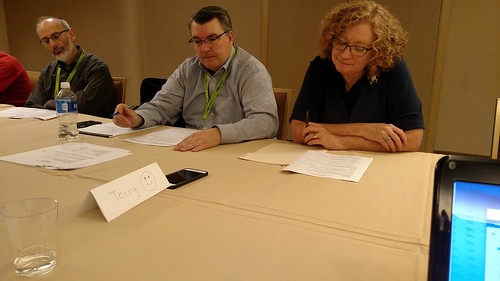
"Terry White", Marc Ricard and Maria Fanning
NBS and MCA Meetings
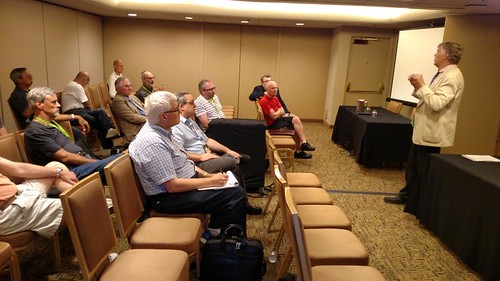
Fred Holabird (right) speaking at 2016 NBS Symposium
NBS President Marc Ricard introduced speaker Fred Holabird after using a whiteboard marker to highlight a phrase left there by a previous speaker in the room: "Thinking out of the box." Fred's theme was on doing numismatic research, and his main point was that to make significant discoveries, once has to get outside of the "box" of what's already been published in the numismatic community.
Joel Orosz took notes, so look for an Asylum article summarizing Fred's great suggestions and stories, which are a must for numismatic researchers and authors.
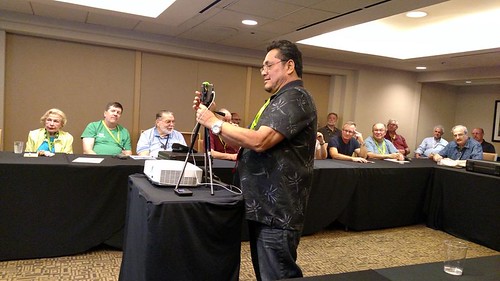
Tony Lopez setting up a live stream video
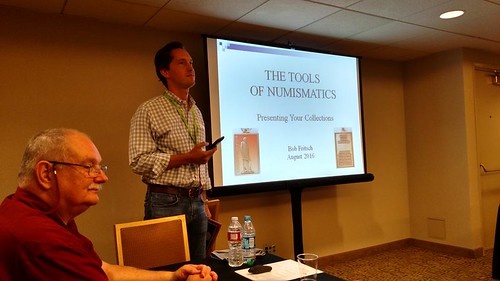
Skyler Liechty (right) introducing speaker Bob Fritsch (left)
After the session E-Sylum reader Darren Burgess of Australia introduced himself to me. It's so nice to be able to finally put a face to an email address, especially when they come from so far away. It was a delight to speak with him about numismatics.
Next I spoke to Bryce Doxson of Maryland about the the Numismatic Ambassador awards and the digitization of the Maryland TAMS group's journal in the Newman Portal.
Rare Legacy
Back on the bourse floor I visited Tony and Skyler at their Rare Legacy table, where an amazing display of historical medals was
beautifully arranged in several cases. Here's just one.
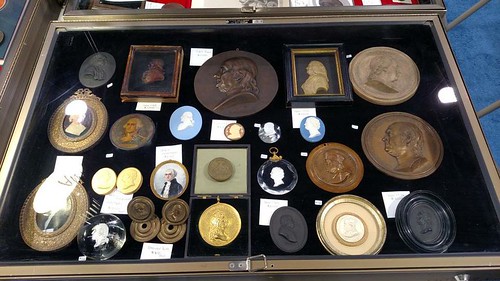
Some NNP Business
Next I sought out Dave Perkins, who kindly agreed to let the Newman Portal digitize his complete set of The Lettered Edge, a
short-lived specialty newsletter on early U.S. silver coins produced by Bob Stark and Jules Reiver.
When I spotted a 1935 Detroit Coin Club membership List in his case, Dave also gathered up and lent us several Detroit club items, including show and banquet programs. This will be great ephemera for the archive section of the Newman Portal.
A Mint Encounter
After walking the bourse floor again I stopped by the Pennsylvania Association of Numismatists (PAN) table and spoke a bit with PAN
President Tom Uram. Tom was on his way to meet Mary Lannin and U.S. Mint Director nominee Rhett Jeppson, and invited me along. We walked
over to the Hilton, snapping these photos on the way.
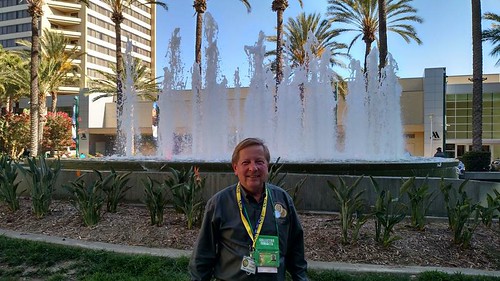
Tom Uram
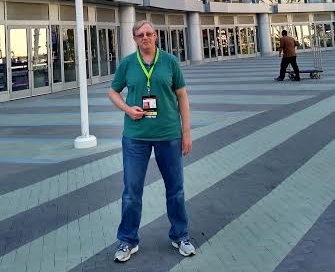
Wayne Homren
At the bar in the Hilton Lobby I got to meet Frank Kovacs, Mr. Jeppson, and a few U.S. Mint staffers. We discussed the Mint's outreach efforts including plans for an October working session on promoting the numismatic hobby. Afterward I went up to my room to change clothes for the NLG Bash.
NLG Bash
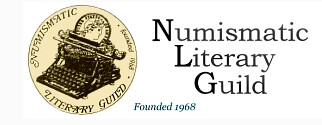
Mark Borchardt invited me to sit at his table, and we also reserved spots for Joel Orosz, Len Augsburger and Len's wife Deb. Already at our table were Denis Loring, John Feigenbaum, Patrick Ian Perez, and Charles Morgan and Hubert Walker of CoinWeek.
I had a scotch and bought Joel a beer. The conversation was great. Charles and Hubert noted that the new book on Numismatic Archaeology of North America was for sale at the show.
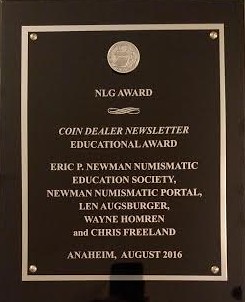 When the festivities began the first award was a new one, the Coin Dealer Newsletter Educational award which went to the Eric P.
Newman Education Society for the Newman Numismatic Portal. Len Augsburger and I went up to accept it and we each hauled back an impressive
plaque.
When the festivities began the first award was a new one, the Coin Dealer Newsletter Educational award which went to the Eric P.
Newman Education Society for the Newman Numismatic Portal. Len Augsburger and I went up to accept it and we each hauled back an impressive
plaque.
Len was quickly back up at the front of the room after the announcement of the NLG's Book of the Year award for "the work
having the greatest potential impact on numismatics", which went to Truth Seeker: The Life of Eric P. Newman, by Leonard
Augsburger, Roger W. Burdette and Joel Orosz. Len and Joel accepted.
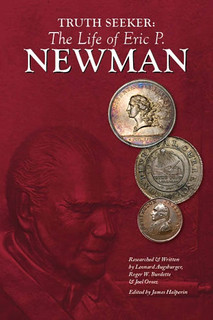 Mark won the NLG's flagship Clemy award and made an excellent acceptance speech. For more about Mark and NLG, see Dave Harper's
Numismatic News article:
Mark won the NLG's flagship Clemy award and made an excellent acceptance speech. For more about Mark and NLG, see Dave Harper's
Numismatic News article:
Congratulations 327 times
(www.numismaticnews.net/buzz/congratulations-327-times)
The highlight for me was a joint presentation by Dave Harper and Clifford Mishler on the life of Numismatic News and Krause Publications founder, the late Chester Krause. The pair took turns remembering Chet, followed up by Dave's amazing vocals on a rendition of Chet's favorite holiday sing-a-long song, the satirical O Lutefisk , sung to the tuned of O Tannenbaum.
Given the heavily Scandinavian heritage of Wisconsin, they explained that Lutefisk is a local delicacy consisting of fish soaked in lye and washed, leaving behind a smelly paste.
Lutefisk, O Lutefisk, how fragrant your aroma,
Lutefisk, O Lutefisk, you put me in a coma.
You smell so strong, you look like glue,
You taste just like an overshoe,
But lutefisk, come Saturday,
I tink I eat you anyvay
Seriously, Dave did a nice job with this, and it was all great tribute to Chet.
To read the complete lyrics, see:
Lutefisk O Lutefisk
(http://lyricstrue.net/bandsongtext/Unknown/Lutefisk_O_Lutefisk.html)
Still on East Coast time, I was quickly running out of gas and had to leave just as the ultimate Odd Couple Fred Schwan and Joe Boling were taking the stage. My apologies to all, but I was done for the night.
To read the complete list of 2016 NLG Winners, see:
Results of Annual
Writers’ Competition for 2016 (www.nlgonline.org/awards/annual-writers-competition/results-of-annual-writers-competition-for-2016/)
Friday, August 12
Len Augsburger and I came across Numismatist editor Barbara Gregory outside the ANA Board of Governors closed session. We later talked a bit with ANA Librarian David Sklow, about multiple topics, including next year's ANA Summer Seminar and Member Appreciation Day at ANA HQ in Colorado Springs (a short drive from next year's convention in Denver, CO).
NBS General Meeting
I went back to my hotel for a while to catch up on email and work a bit on The E-Sylum. Come 11:30 I was at the NBS General Meeting,
where Len and I were to give a brief overview of the Newman Portal.
It was great to see so many fellow NBS members and E-Sylum readers in attendance including David Alexander, Len Augsburger, Ken Bressett, George Kolbe, Denis Loring, Doug Mudd, Jim Neiswinter, P. Scott Rubin, Eric Schena, David Sundman and others.
Before the meeting began I was delighted to meet twelve year old numismatist Kellen Hoard from the Seattle area. He found the NBS web site online, became an E-Sylum reader at my invitation, and has become a voracious consumer of content on the Newman Numismatic Portal.
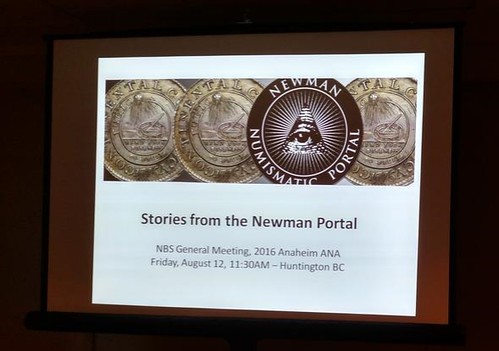
After an introduction by NBS President Marc Ricard, Len Augsburger and I spoke on the Newman Numismatic Portal. I opened the NNP segment by recounting a story highlighting the need for a comprehensive numismatic literature search engine. Back on 2007 I commented in The E-Sylum about an auction lot description of an Albany Church Penny, where the cataloguer wrote that "nothing is known" about the issuer or manufacturer. That struck me as incorrect, for I remembered seeing a detailed article on the topic once. I wrote:
We bibliophiles hate to take "nothing is known" as our final answer. The cataloger may not know anything more about the piece, and we may not either, but we do know that surely SOMEone, SOMEwhere, SOMEtime in the past two centuries has recorded SOMEthing of interest.
Because I knew where to look for these things, I soon found a 1944 article in The Numismatic Scrapbook Magazine and others in The Colonial Newsletter. So a lot was indeed known about the piece, just not known to the cataloguer. The world needed a single, fast way to search the corpus of numismatic literature. That need led me to build my own Coin Library search engine and eventually team up with the Newman Portal.
To read the complete article, see:
ALBANY CHURCH PENNY RESEARCH FOLLOWUP
(www.coinbooks.org/esylum_v10n02a18.html)
Len followed me with a presentation highlighting some of the special content that is already part of the portal, not just in the search engine, but fully available for reading on the site.
Next it was time for the NBS fundraising auction. I'd donated a few items myself and was curious to see how much they'd bring. I also hoped to bid on a few other items. A visitor from Ireland graciously agreed to be auctioneer David Fanning's "Vanna White" to hold up and display items up for bid. Marc Ricard recorded the winning bids.
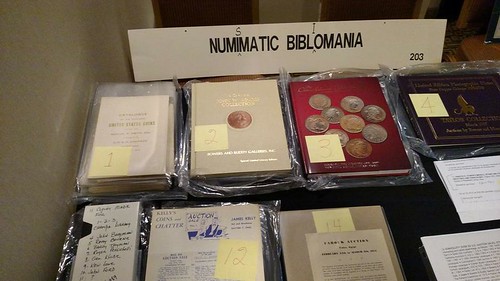
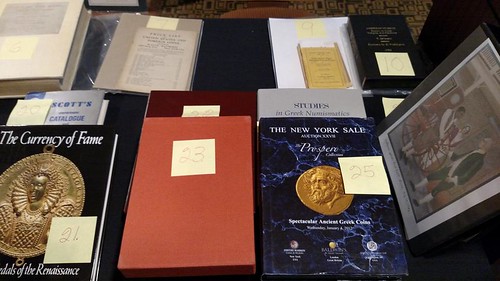
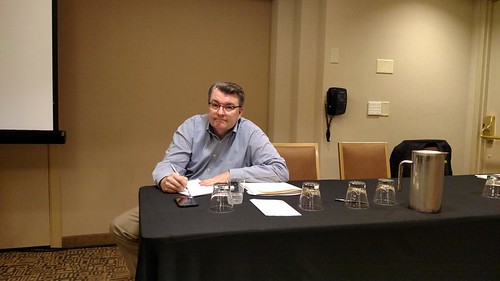
Marc Ricard recording sales
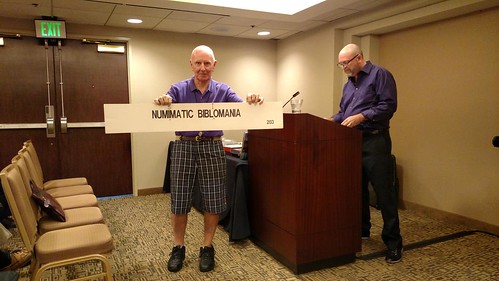
"Vanna White" and David Fanning
I purchased a couple items and was happy to see the club raise over $3,000 for the Treasury.
Lunch
After living on Food Court sandwiches for lunch and dinner all week, I was more than ready for a change. I recruited David Sundman and
George Kolbe for lunch anywhere BUT the Food Court. We ended up at the Hilton's restaurant. Service was slow but the company and food
were top notch.
Next I took an hour or so to work on The E-Sylum before heading to the lobby to meet Joel Orosz - we'd planned to go over to the convention to see the exhibit area.
While waiting for Joel I ran into Ken Bressett, who was on his way to a meeting of the International Primitive Money Society. I told him about an archive of papers from the Howard Gibbs estate that I've been trying to get organized for scanning into the Newman Numismatic Portal. Gibbs was one of the biggest collectors ever of Odd and Curious money, and the archive includes an inventory of his collection and correspondence with dealers and collectors.
When Joel joined us the conversation had drifted to Hans Schulman, who sold Gibbs' collection in several auction sales. Ken remembered him as someone who you knew going in was going to get the best of you in any coin deal, but he was so charming that you didn't notice or mind.
We also talked a bit about dealer B. Max Mehl. Ken is one of just a few people alive who had met Mehl in person (the others include Dave Bowers and Eric Newman). Mark Borchardt happened by and I congratulated him on his NLG Clemy award. We talked about the Clemy typewriter which winners once had to lug home with them and haul back the next year. Now it lives year-round at the ANA headquarters in Colorado Springs.
Exhibits
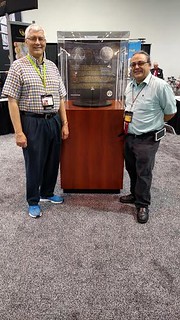 Next Joel and I headed back to the convention center. We ran into Eric Schena and invited him with us on our mission to see the exhibits.
First we stopped at the U.S. Mint booth where the 1974-D aluminum cent was on display, where I took this shot of Joel and Eric.
Next Joel and I headed back to the convention center. We ran into Eric Schena and invited him with us on our mission to see the exhibits.
First we stopped at the U.S. Mint booth where the 1974-D aluminum cent was on display, where I took this shot of Joel and Eric.
Below are some of the great exhibits we saw.
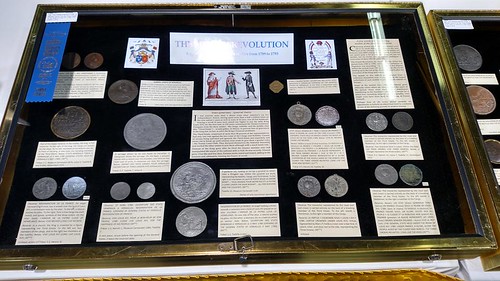
The French Revolution
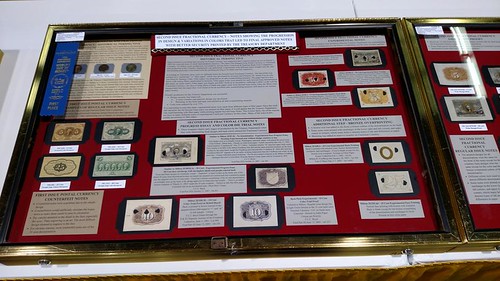
Fractional Currency
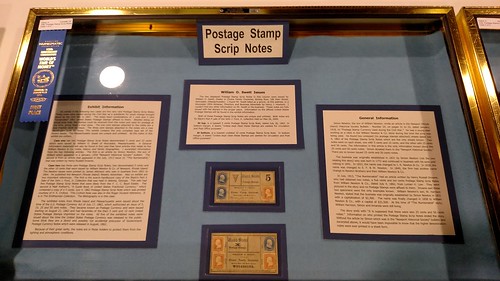
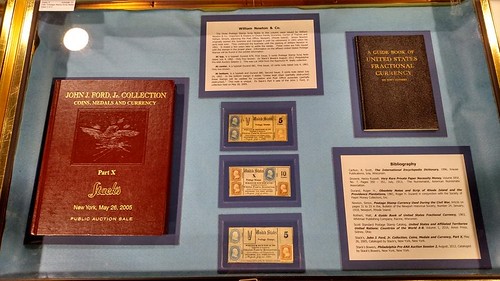
Civil War Postage scrip notes
Dinner
I hadn't bought an ANA Banquet ticket and was sorry to miss the event, where John Kraljevich would be accepting his Numismatist of the
Year award. But I was happy to organize a more casual event with others who weren't going to the banquet either.
Meeting at the Kolbe &Fanning table, I got together with Len Augsburger and his wife Deborah, my fellow Nummis Nova member Eric Schena, Joel Orosz and young numismatist Kellen Hoard and his mother Cathy.
Kellen collects Liberty Seated coins, so Len stopped by his table and gave him a new copy of the new Liberty Seated Red Book. On the way to get a couple cabs to take us to the restaurant, we stopped for these group photos.
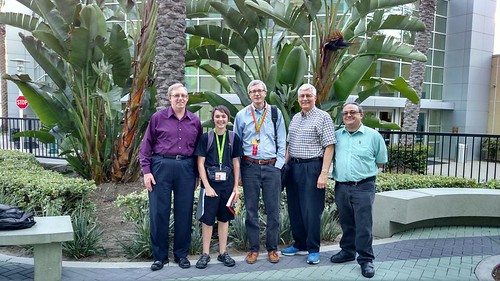
Wayne Homren, Kellen Hoard, Len Augsburger, Joel Orosz Eric Schena
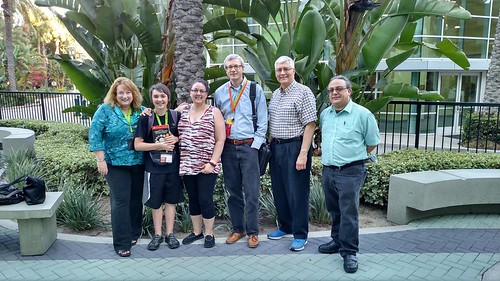
Deb Kurtz, Kellen Hoard, Cathy Webb, Len Augsburger, Joel Orosz, Eric Schena
We went to a Hawaiian-themed place called Roy's Restaurant at the nearby Anaheim Garden Walk. We split up into two cabs to get there, and I was delighted to finally have a chance to say,"Follow That Cab!" Deb had made us a reservation and we were quickly ushered to a waiting table.
The evening was a lengthy blur of great food and conversation. Joel and I sat across from Kellen and his Mom Cathy. Next to me was Eric, and Deb and Len were across from him. Joel got things started by asking each of us to describe how we first got interested in collecting. Joel then started a second round by asking us to name the most historically important items in our collections. Along the way Kellen showed us some of his acquisitions from the show and his recently-published Letter to the Editor in The Numismatist, a well-written response to an article about formal degrees in Numismatics and something you'd never guess was written by a twelve year old.
It was a wonderfully enjoyable night, and we decided to just walk back instead of bothering with more cabs. Before long we were saying goodnight in the Hilton lobby, where all of us were staying.
Saturday, August 13
Rittenhouse Breakfast
At 7:30 Saturday I attended the annual Rittenhouse Society breakfast. A small group of top numismatic researchers and authors, I'm
quite honored to be a member. The group was founded back in 1957 by then-young numismatists Ken Bressett and Dave Bowers, both of whom were
present.
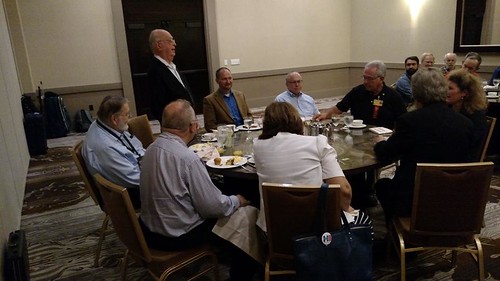
Neil Shafer discussing his project
After breakfast we go around the room and everyone introduces themselves and mentions their current research projects. Neil Shafer noted that he was working on a book with Ray Feller about Short Snorters, the souvenir signed banknotes popular in WWII, which sometimes consist of several notes taped together in a long string. Afterwards I asked if the book would have centerfold. Neil made a pose and said, "It's me!"
Maybe not. But a great topic for a book that's been long in coming. Before leaving I took this shot of Dave Bowers with Mary Burleson of Whitman Publications, our host for the event.
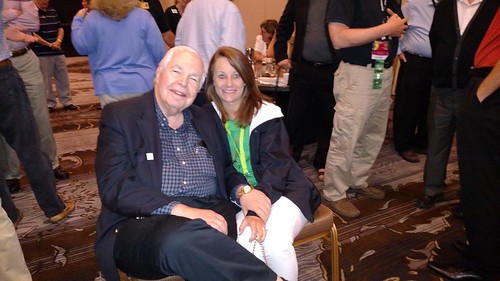
Money Talks
Next up was a 10am Money Talks presentation on the Newman Numismatic Portal with Len Augsburger. In the audience was E-Sylum reader
Steve Costner of North Carolina, as well as Kellen Hoard and a half dozen others. With the convention winding down, we hadn't expected
a big crowd. Afterwards Steve told us he planned to introduce the Portal to his Boy Scout group. Thanks!
Winding Down
After the Money Talks meeting I went back to my room to pack. In the elevator I ran into Dave Bowers and we wished each other pleasant
travels. I grabbed some lunch and went out front to wait for my airport shuttle. Already waiting there was Ken Bressett. We were heading to
different airports but had a chance to chat for a while first. Where else could you constantly be bumping into such numismatic
luminaries?
My return flight was uneventful and I managed to work a bit on this diary before the battery on my laptop ran out. We landed around 11pm local time and outside the heat was sweltering - still in the 90s! I drove home and pulled up to my house just as the clock turned to midnight.
It was a productive and enjoyable trip. My apologies to those readers I ran into but forgot to mention here. It was all a blur. I'm glad I got to see so many of you in person for a change. 'Til next time!
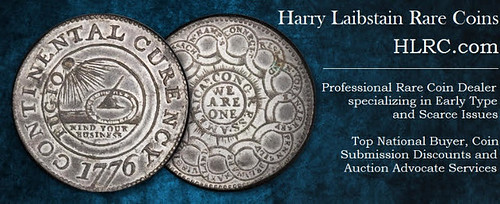
QUERY: YEMENI COINS IN COLONIAL AMERICA
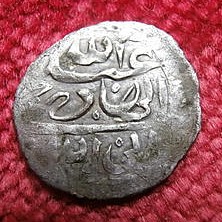

I’m presently writing an article for The Colonial Newsletter (CNL), a research journal published by the American Numismatic Society, on the origin and circulation of Arabian gold and silver coins during the late 17th century in the American Colonies. I’m assisted by CNL Editor Chris McDowell. The article to be published in January of 2017 examines an extensive number of primary source documents and examines a total of eight specimens of Arabian silver (three whole coins and five fragments), all of which were found by detectorists at Colonial Period sites in New England.
I believe these coins represent a small sample of countless others brought to the colonies by pirates that plagued trade between the East Indies and the Red Sea in the late 17th century. I have obtained extensive primary source documents on the origins and circulation of the coins.
The connection between the coins and piracy is hard to dispute. England’s mercantile system ensured that no direct trade took place between the East Indies and the colonies, but the colonies sent many ships to go “on the account” in the Red Sea using dubious privateer’s commissions to attack French shipping.
Rhode Island was first and foremost on these piratical endeavors, and the colony’s extensive involvement is epitomized in the historical record concerning the capture of two Mughal vessels, the Fateh Muhammed and the Ganj-i-sawai in the Arabian Sea in early 1695. These two vessels were taken by several pirate ships working as a squadron to seek out the Indian fleet on its return home after the annual pilgrimage to Mecca. Mocha was the last stop for the fleet on its return from Haj, and the port made extensive use of Khums Kabir coins in its trade. The better known pirate captains in the squadron included Henry Every of the Fancy and Thomas Tew of the Amity. While Thomas Tew was from Rhode Island, he was killed in action while attempting to capture the Fateh Muhammed; however, most of the pirate vessels in the squadron were also based in Newport.
Newport remained at a safe distance and indifferent to the unfolding outrage over the attack on the Mughal fleet. All the perpetrators sought to avoid discovery, and Rhode Island proved to be a good option. News of the incident was bad for England and its overseas trading interest, as The Ganj-i-sawai was a treasure ship belonging to Mughal Emperor Aurangzeb, and its loss to the pirates was estimated to total somewhere between £200,000 and £600,000. This amount included 500,000 gold and silver pieces. The coin that I recovered only a few miles from Newport Harbor very likely came from this tremendous haul, one of the largest scores in the history of piracy.
While the coin can never be directly attributed to any specific pirate, its connection to piracy is beyond all doubt due to its year of mintage, its origins from Yemen, and its recovery from a late 17th century context in Newport, RI. Proper identification of the coins in this study is my only hindrance toward publication on a subject matter that has gone too long without any in depth study. The upcoming article will offer the first documented recovery of Arabian silver coins in North American; furthermore, it’s in depth examination of piracy as a source for the coins is unprecedented.
To read Jim's account of his discovery on Treasurenet.com, see:
1693 HAMMERED SILVER - A
PIRATE'S COIN! (www.treasurenet.com/forums/today-s-finds/417331-1693-hammered-silver-pirates-coin.html)
ARTICLE HIGHLIGHTS SALE OF 1792 COINS
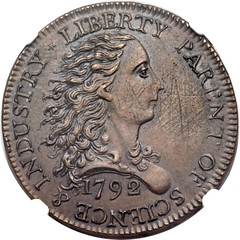 Two rare one-cent coins from the earliest days of the U.S. Mint have sold for a pretty penny.
Two rare one-cent coins from the earliest days of the U.S. Mint have sold for a pretty penny.
The copper coins, both dating to 1792, went for a combined total of $869,500 at the auction held Wednesday in Anaheim, California.
One of them, known as the "Birch Cent," sold for $517,000. The other, known as the "Silver Center Cent," went for $352,500.
Eric Bradley, spokesman for Heritage Auctions, said that while the sales fell somewhat short of the combined $1 million the auction house projected they would go for, organizers are still pleased with the result.
"We're looking at two coins that sold for more than 43 million times their face value," Bradley said, "so you can't be disappointed in that."
The coins have historical significance that goes beyond their collectible value, representing "the transition in American history from the colonies to a new republic," Bradley said.
"These are coins that were developed and thought up by the Founding Fathers who were trying to differentiate themselves from British coinage and British rule," he said.
The words "Liberty Parent of Science &Industry," which are engraved on both coins, also show how the United States was trying to distance itself from the religious persecution and monarchy it associated with Britain, Bradley said.
The origin of the Silver Center Cent was also referenced in a letter from Thomas Jefferson to George Washington, and it is among the very first coins ever struck by the U.S. Mint in Philadelphia, Bradley added.
According to the auction house, the coin went missing before eventually being discovered in an English pub in the 1960s. The man who discovered it, Nigel Willmott, kept hold of it until 1997, when he eventually auctioned it off for 28,750 British pounds, Bradley said.
The penny's name derives from the fact that it was produced with a small insertion of silver at its center, a feature which made its intrinsic value equal to its face value. It is one of about a dozen surviving coins known to exist with this insertion, Bradley said.
To read the complete article, see:
2 1-cent coins from early US sell for combined $869,500
(www.yahoo.com/news/2-early-us-1-cent-062415549.html)

HOW MUCH ARE OLYMPIC MEDALS WORTH?
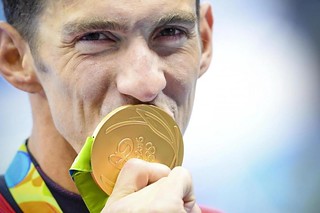 Michael Phelps is very, very rich. He’s worth tens of millions of dollars in endorsement deals and gets paid a pretty sum for his
accomplishments in the pool.
Michael Phelps is very, very rich. He’s worth tens of millions of dollars in endorsement deals and gets paid a pretty sum for his
accomplishments in the pool.
He also owns a lot of precious metal.
After 22 gold medals in four Olympic games, if Phelps wanted to sell his collection it would probably fetch millions of dollars, sports memorabilia appraisers say.
Olympic gold medals have a tiny but dedicated collector following. A single medal from a modern Olympiad is worth upward of $30,000, depending on the athlete. Ukrainian boxer Wladimir Klitschko sold his 1994 medal for $1 million in 2012. Mark Wells, a member of the 1980 “Miracle on Ice” U.S. hockey team, sold his in 2002 for $40,000.
Phelps’s medals are worth at least $100,000 a pop, maybe more if they're from an especially noteworthy race. The legend of Michael Phelps, the most awarded Olympic athlete of all time, is worth a whole lot of money.
"There’s something about what just happened [in Rio de Janeiro] that makes him different,” said Brian Steiner, the chief executive of memorabilia appraisal at auction house Steiner Sports. “This was the one that somehow catapulted him to some other kind of greatness.”
As scrap metal, Phelps’s golds are worth more than $10,000. “Gold” medals since the 1912 games in Stockholm aren’t actually made of gold. They’re gold-plated — about 1 percent gold — with the rest an alloy of silver and copper.
The Rio gold medals weigh 500 grams, the heaviest medal ever awarded in a summer games. So far, Phelps has won four of them. That’s $1,144.80 worth of gold this year and another $1,320.60 in silver.
With awards there is an intrinsic value, but with medals it’s really only what is without any intrinsic value,” said Mike Provenzale, sports production manager at Heritage Auctions. “It’s all about what it is and not what it’s made of.”
Heritage sells a lot of NBA and NFL championship rings loaded with diamonds and gold. Those do have intrinsic value, Provenzale said. As a gaudy ring, it’s probably worth $10,000. But buyers will spend $20,000 on them: half for the cost of the materials, half because they really love their favorite teams.
Olympic medals, even vintage medals, don’t work like that. Heritage is selling a diving medal from the 1936 games in Berlin. It’s intrinsic value, adjusted for 2016 gold and silver prices, is less than $100. Provenzale still expects it to sell at auction at the end of the month for more than $20,000.
To read the complete article, see:
How much are
Michael Phelps’s gold medals really worth?
(www.washingtonpost.com/news/wonk/wp/2016/08/12/how-much-are-michael-phelpss-gold-medals-really-worth/)
The design to redevelop Marine Park, in Brooklyn, had been beautifully sketched in oil onto a large rectangular canvas. The map showed a thin canal, almost perpendicular to the South Brooklyn shoreline, which ran into a circular pool. It lay ready for inspection in a spacious exhibition hall, just outside the monumental Olympic Stadium in Berlin.
The drawings, signed in a calligraphic style on the bottom righthand corner by their creator Charles Downing Lay, were the American entry into the 1936 Summer Olympics—also known as the Nazi Olympics—for a category that seems improbable today: Town Planning.
Yes, from 1928 until 1948, town planning was an actual Olympic sport.
Town planning fell under an "architectural design" category at the Olympic art competition. The field that year was dominated by German entries. Yet the first U.S. medal of the Olympics went to Lay, a New York architect, for his ambitious blueprint to modernize Marine Park in Brooklyn.
To read the complete article, see:
America's First Medal at
the Nazi Olympics Was For...Town Planning
(www.atlasobscura.com/articles/americas-first-medal-at-the-nazi-olympics-was-fortown-planning)
The first American woman to win an Olympic gold medal wasn’t aware of what she’d won. In fact, records suggest she went her entire life oblivious to her historic achievement—and if it weren't for one professor's decade of detective work, the story of top prizewinner Margaret Abbott would still be unknown to the world.
To read the complete article, see:
The First
American Woman to Win an Olympic Championship Didn't Even Know It
(www.atlasobscura.com/articles/the-first-american-woman-to-win-an-olympic-championship-didnt-even-know-it)
THE BOOK BAZARRE
POLICE SOLVE WWI SOLDIER MEDAL MYSTERY
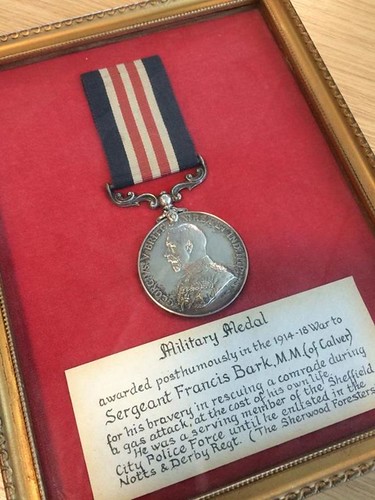 The story behind a WW1 medal discovered in a cupboard at a police headquarters has been pieced together by officers.
The story behind a WW1 medal discovered in a cupboard at a police headquarters has been pieced together by officers.
South Yorkshire Police made an appeal for information in July to coincide with the Battle of the Somme anniversary.
The medal was awarded posthumously to Sgt Francis Bark of Calver, Derbyshire, who died of gas poisoning in France in May 1918.
Sgt Bark worked for Sheffield's police service from 1913 until World War One.
The force thanked the public for their help in solving the mystery.
A spokesman said: "With a huge thank you to all of you who helped piece together the story of Sgt Francis Bark, we are pleased to tell the story of an officer/soldier who gave his life for others nearly 100 years ago."
The soldier died of gas poisoning aged 26 on the day his battalion was due to leave the frontline for a well-earned rest.
A diary entry from 27 April 1918 stated: "The enemy burst 9 of our gas cylinders by shell fire amongst a post and working party of 'A' company 2 Lt Harding and fifty other rank casualties."
He was awarded the medal "for bravery in rescuing a comrade during a gas attack, at the cost of his own life". The medal, with 14 shillings, was given to his father who passed it to the police force as Francis' employers.
To read the complete article, see:
Police solve WW1 soldier medal mystery
(www.bbc.com/news/uk-england-south-yorkshire-36996568)

MOVIE PROP MONEY GETS DRUG BUYER A BEATING
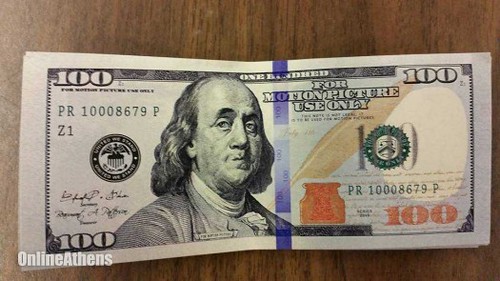
The use of motion picture prop money by criminals turned violent this week when a purported drug dealer allegedly attacked a customer who attempted to make a purchase with the counterfeit currency.
Athens-Clarke County police have regularly encountered prop money over the past month, mostly when investigating reports of fraud, when prop money was passed by customers when paying for food or merchandise.
Now the prop money, which is clearly marked “FOR MOTION PICTURE USE ONLY,” has turned up at the scene of a violent assault. According to a police report, 30-year-old Ramon Tyres Jones used a baseball bat to beat a customer because he “was angry at (the customer) for receiving two motion picture $100 bills” in payment for marijuana.
The victim suffered injuries to his nose, shoulder, elbow and back of the head and was taken by ambulance to Athens Regional Medical Center.
To read the complete article, see:
Movie prop money usage in Athens leads to
violence (http://onlineathens.com/mobile/2016-08-12/movie-prop-money-usage-athens-leads-violence)

INTERVIEW WITH COUNTERFEITER FRANK BOURASSA
 In May 2012, the Canadian police seized $1 million worth of fake US $20 bills and arrested four suspects in Trois-Rivières, Quebec.
In May 2012, the Canadian police seized $1 million worth of fake US $20 bills and arrested four suspects in Trois-Rivières, Quebec.
The officers on the scene were immediately struck by the quality of the counterfeit notes.
"It's highly sophisticated, no doubt about that," Sgt. André Bacon of Canada's federal police force, the Royal Canadian Mounted Police, told CBC news at the time.
The police described the fake notes as "virtually undetectable to the naked eye," according to an archived press release from 2014. As well a looking just right, the counterfeit 20s felt identical to real notes, and they came with a "dark vertical stripe" that perfectly imitated the security thread on the real bills. The way banknote paper feels is a large part of currency security — it is made in only one mill, which makes only money.
Local man François Bourassa was immediately charged with the "production, possession, and distribution of counterfeit currency" and is the only suspect named in the CBC report.
Because of the remarkable quality of the counterfeit cash, the police assumed it was the work of a large and sophisticated criminal gang. Perhaps that's one reason that Bourassa served only six weeks in prison and paid a fine of about £1,000, or $1,300 at today's exchange rate, after handing in $200 million in counterfeit $20 bills before facing trial.
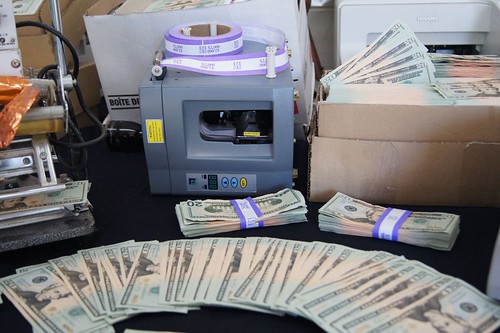
Bourassa says he made $250 million worth of fake notes. He is often asked where the other $50 million is. The missing stack of bills weighs about 2.5 tonnes (about 2,500 kilograms, or 5,500 pounds) and if stacked one by one would reach 250 metres, or about 820 feet.
"You would have to ask my accountant about that ... it implies complex mathematical questions," Bourassa, who refers to himself as the "Counterfeit God," told Business Insider.
Frank was supplementing his savings by getting involved in the booming illegal marijuana trade. This came to an end in 2006 when Frank was convicted on a drug-related charge and incarcerated for three months.
In 2008, as a free man able to go on long drives again, Frank had the epiphany he had been waiting for:
"It occurred to me at a red light: Why the hell go through all this hassle of finding product, selling it, finding customers, accounting, and all of that trouble, to bring it back as money?"
"I loved money so much I decided to make my own," he said.
"I figured it was going to be very hard, but it was never daunting," Frank said. "I've been engineered from birth to find solutions for anything."
Frank settled on the $20 bill. It is less suspicious than the $50 or $100 notes. Its design at the time was older, with worse security features than the $10 bill. He did his research by moving between various internet cafes in Quebec, not wanting to draw attention to himself in any one location.
There were two major stages to the printing process. First, Frank had to source the paper used in US bank notes — a blend of cotton and linen that is unique to currency producers in the US. Second, he had to buy the very expensive printing equipment and software.
Frank said ordering the paper was a "huge undertaking" and probably the toughest part of the process.
To read the complete article, see:
We talked to the 'God' of
counterfeiting who printed $250 million in fake cash — and got away with only 6 weeks in prison
(www.businessinsider.com/frank-bourassa-on-how-he-counterfeited-250-million-2016-8/#-1)
To read the earlier E-Sylum articles, see:
COUNTERFEITER FRANK BOURASSA (www.coinbooks.org/esylum_v17n21a30.html)
MASTER COUNTERFEITER FRANK BOURASSA
(www.coinbooks.org/esylum_v17n45a30.html)
THE BOOK BAZARRE
FEATURED WEB SITE: TOM CHAO'S PAPER MONEY GALLERY
This week's Featured Web Site is Tom Chao's paper money gallery.Hi, my name is Tom Chao. My hobby is collecting paper money from different countries of the world.
I have been collecting paper money since 1991. My goal is to collect at least one note from each issuing country of the world. I started my collection with a mail order package of 50 different uncirculated world banknotes I bought for $9.95. My earlier purchases were notes selling for under a dollar each. Gradually, however, I began to add more expensive notes. Eventually as I become a more advanced collector, I got rid of most of those "penny" banknotes. I bought my notes mostly online from dealers and auction houses.
My blog, Some Interesting Facts About Paper Money, offers timely articles and commentaries on paper money related topics.
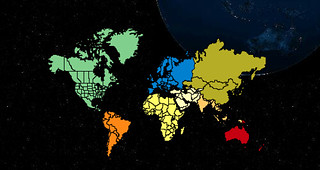
http://tomchao.com/
THE BOOK BAZARRE

